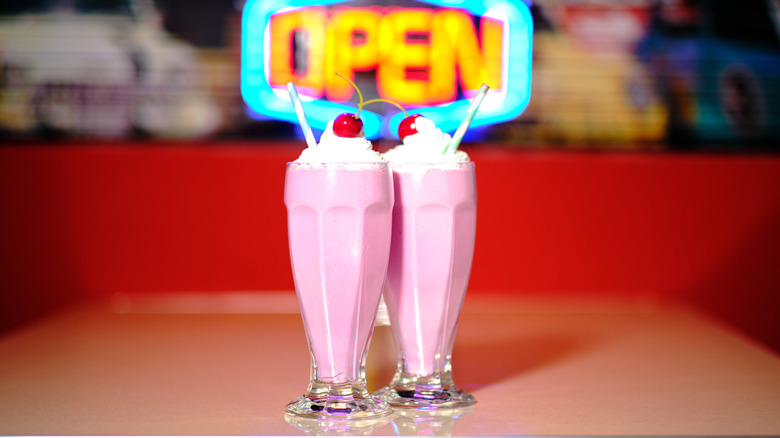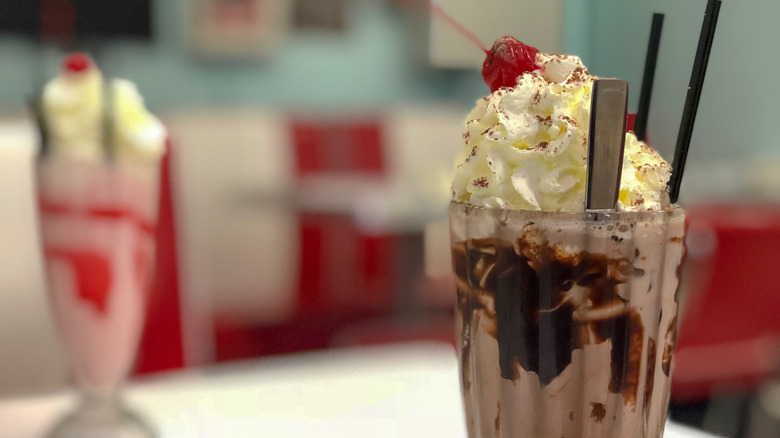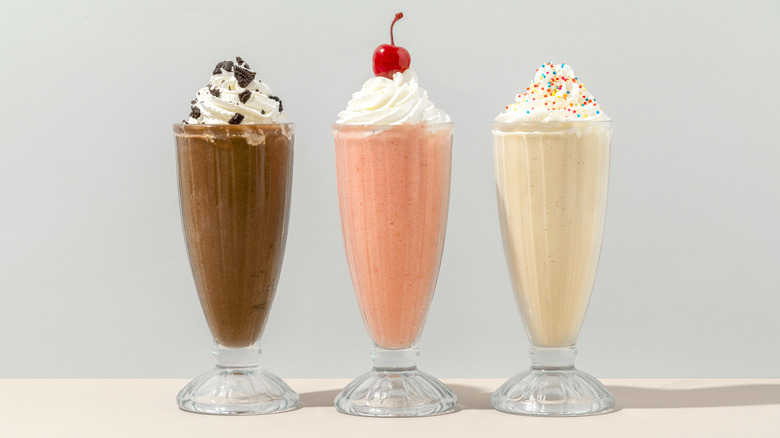Why Milkshakes Always Taste Better At A Diner, Explained
Whether you're grabbing a shake at Ray's Candy Store in New York City or making the weekly pilgrimage to your favorite local diner, you've probably wondered why some foods (like pancakes and waffles) just taste better at the diner than they do at home — and you aren't alone. There are a few reasons why the diner milkshake game is stronger than yours, and it's not your fault, for the record.
For starters, that signature decadent texture requires special mixing equipment to achieve. Restaurant-grade milkshake mixers put diners at an advantage, even if you're really good at whipping up a homemade treat. Commercial milkshake machines run as much as $1,000, and it's fair to say they're better suited for the job than a home cook's trusted all-purpose blender.
The element of nostalgic appeal is also undeniable. At the longstanding Kewpee Hamburgers in Lima, Ohio, the diner is churning out frozen malts so thick that they need to be eaten with a spoon — and yet a medium costs less than $3 (three cheers for nostalgic pricing, too boot). That thick, creamy texture is especially hard to replicate when the diner's chilled, retro glassware and familiar, comforting ambiance enter the picture. After all, your living room can do a lot of things, but chances are it can't feel the way a beloved establishment feels.
High-quality, full-fat ingredients speak for themselves
Beyond the equipment, diners also have their ingredient game locked down. Perhaps unsurprisingly, many diners tend to keep the specifics of their proprietary milkshake recipes a secret. Either way, the ingredients required to shake it up may be straightforward and minimal, but this does not mean they can be overlooked. High-quality, full-fat ice cream and full-fat whole milk make for the thickest, creamiest texture — crucial to achieving that luscious diner shake trademark.
Diners also tend to keep it simple. Brownie chunks, rainbow sprinkles, cookie dough bites, fresh fruit pieces, crunchy nuts, candy bars, and chocolate-hazelnut spread all make delicious mix-ins, but at most traditional diners, the flavors are uncomplicated and consistent: iconic chocolate and old-fashioned vanilla, or at most, the Neapolitan triad.
Some diners use slightly softened ice cream for easier, creamier blending. And yet another possibility regarding the secret to a superior shake is a shot of syrup in the blender. This may be the diner realm, but we aren't talking about maple syrup here. Vanilla syrup boosts a vanilla milkshake, chocolate syrup boosts a chocolate milkshake, strawberry syrup on strawberry ice cream, etc. For foodie fans of a chocolate and vanilla combo, look no further than the diner classic flavor "black and white" — vanilla ice cream with chocolate syrup.
The pros know the ratios
As professional and novice milkshake lovers know, it's all about nailing the ingredient ratios, and diners have it down to a science. If practice makes perfect, then chances are that even a lousy diner has way more practice under its belt than the average home cook, slinging milkshakes daily for the diner-going masses. Pondering proportions is old hat for an establishment whose job it is to serve food all day.
So, what is that elusive golden ratio? Some folks say it's 2 cups of ice cream to ⅔ cup of whole milk, plus the mix-ins of your choice. Others say that 1 cup of ice cream to ¼ cup of milk is ideal, although some diners don't use milk at all unless it's frozen. Known for being "awful big and awful good," the signature shake from Bond's in New Jersey is actually called the Awful Awful, and is made with ice milk, flavored syrup, and just enough ice cream to achieve a creamy, thick texture. The chain sold its name to another northeast-based chain, Newport Creamery, which has been serving up the Awful Awful since the 1940s.
Long story short: Even if you can't get your recipe to be quite as good as a diner's, there are a lot of ways to make a killer milkshake. Feel free to get creative as you recreate your favorite restaurant shake at home, but the cherry and king-sized paper straw are probably mandatory.


